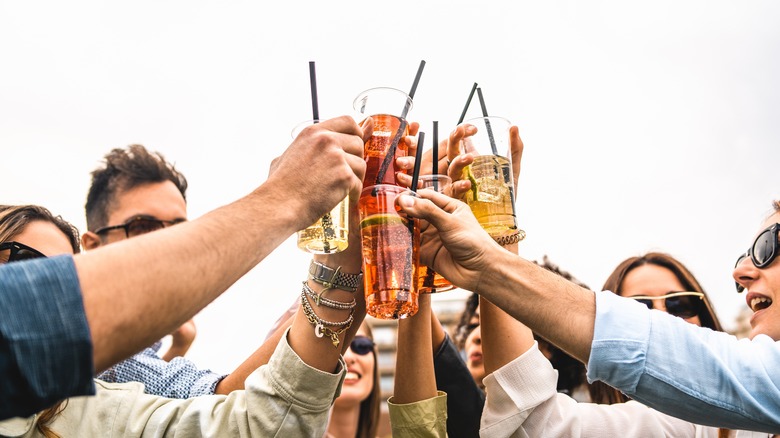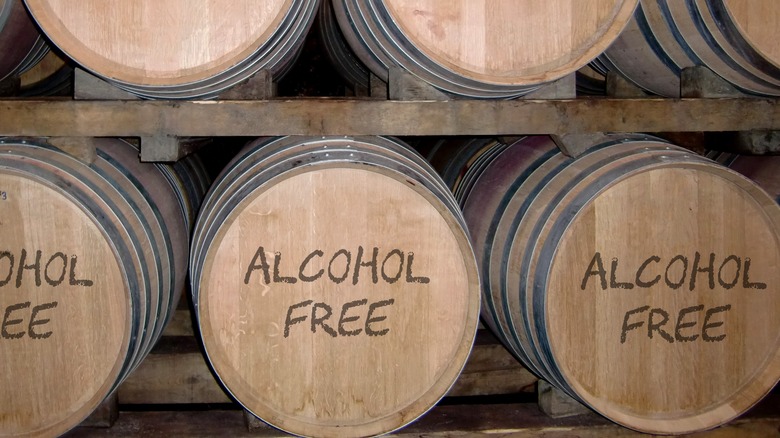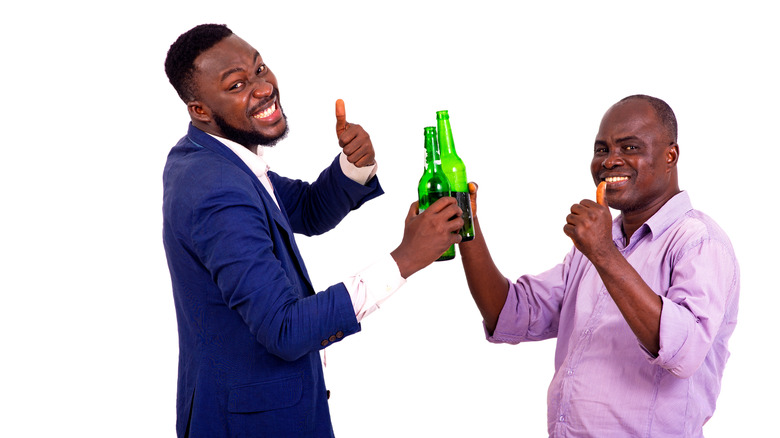Why Dry January Promises To Be Bigger Than Ever In 2023
Dry January is getting to be sort of a thing. First started in 2012 by Emily Robinson in preparation for a half-marathon, the idea has really taken off (via Alcohol Change). It's not terribly surprising if you think about it: December is typically a month of indulgence for most, as holiday parties proliferate and revelers partake of a bevy of seasonal treats and spirits. January brings the new year and thoughts of reform and resolutions, with a large percentage of those resolutions are focused on health and wellness, with healthier diets, weight loss, and exercise topping the list (per Statista). As people consider improving their quality of life, decreasing alcohol consumption is often a natural place to turn, and getting on board with a group movement like Dry January makes it easier to make better and lasting changes (via The Washington Post).
A reported one in five adults were participating in the movement in January of 2022, with Millennials representing the largest percentage of those numbers (per Morning Consult) — an approach that has gained considerable traction over the past decade. That means that non-drinkers are starting to account for a considerable market share. Companies are offering more — and much better quality — non-alcoholic beverages, from "near" beer to canned mocktails, and sales are booming. NPR's Planet Money newsletter went so far as to call this a "golden age" of non-alcoholic spirits (via NPR), noting Nielsen data showing that the market for non-alcoholic drinks is growing annually at 20% (per Nielsen).
It's not just O'Douls anymore
Some of the companies making non-alcoholic options aren't so new: O'Douls (made by Anheuser Busch) has been around for decades; Seedlip, (the first non-alcoholic distilled spirit) was founded in 2013 (per Crafted Society); and Curious Elixirs got its start in 2017 (including adaptogens, rather than spirits, in its creative mocktails, via The Zero Proof). But many are jumping on the bandwagon just now. As Nielsen reports, "Between mid-July 2021 – mid-July 2022, 72 new non-alcoholic drink SKUs were introduced to the US market: 37 were non-alcoholic beer, 17 non-alcoholic wine, and 18 non-alcoholic spirits" (per Nielsen). Pinterest has predicted a growing increase across the board, and the platform saw a consistent, increased search for both mocktails and "fancy" non-alcoholic drinks (via Pinterest).
NPR notes that celebrity involvement is making these beverages more visible: both Katy Perry and Bella Hadid have gotten in on the action, and a host of famous people — from Lance Armstrong to chef David Chang — have invested in Athletic Brewing (via NPR and Business Wire). The non-alcoholic beer company's annual revenue is now estimated at over $49 million. Inc. noted that it's a real contender in the field, listing it as the 26th-fastest growing company in 2022. Athletic now boasts a wide range of craft beer options and sparkling waters, which can be ordered straight from the website, meaning that consumers have ready access to their offerings (per Athletic Brewing).
Damp January, all year round?
In addition to the objective growth in the market is another little factor: more of these non-alcoholic options out there are actually worth drinking, as an Inc. article's title aptly demonstrates ("How Athletic Brewing Company Made Moderation Cool. Hint: Tasty Beer). People drink alcohol for its effects, as a habit, for their health, to celebrate ... but they also drink for taste. As companies gain more experience developing non-alcoholic beverages for consumer demand, there are a lot more things to drink, and many of them actually taste good. Sometimes, really good.
These days, there are options to suit a variety of palates and preferences, providing ample fodder for opinions, as newspaper ratings have made clear (via The New York Times and The New York Post).
So, is this "new temperance" movement here to stay, as some, including The Washington Post, have suggested? That depends on what we mean by temperance. Analysts have noticed an interesting element of the sales in non-alcoholic beverages. While a number of those purchasing non-alcoholic products are substituting them for the "real thing," many others are adopting a "Damp January" approach (via Fortune), buying both alcoholic beverages and non-alcoholic alternatives in what looks like a push for moderation, rather than complete abstinence (per NPR). Interestingly, that group of moderates is bigger overall spenders than either their booze-focused or non-drinking friends.
It looks like a "both/and" approach to drinking is here to stay: another face of inclusivity.


